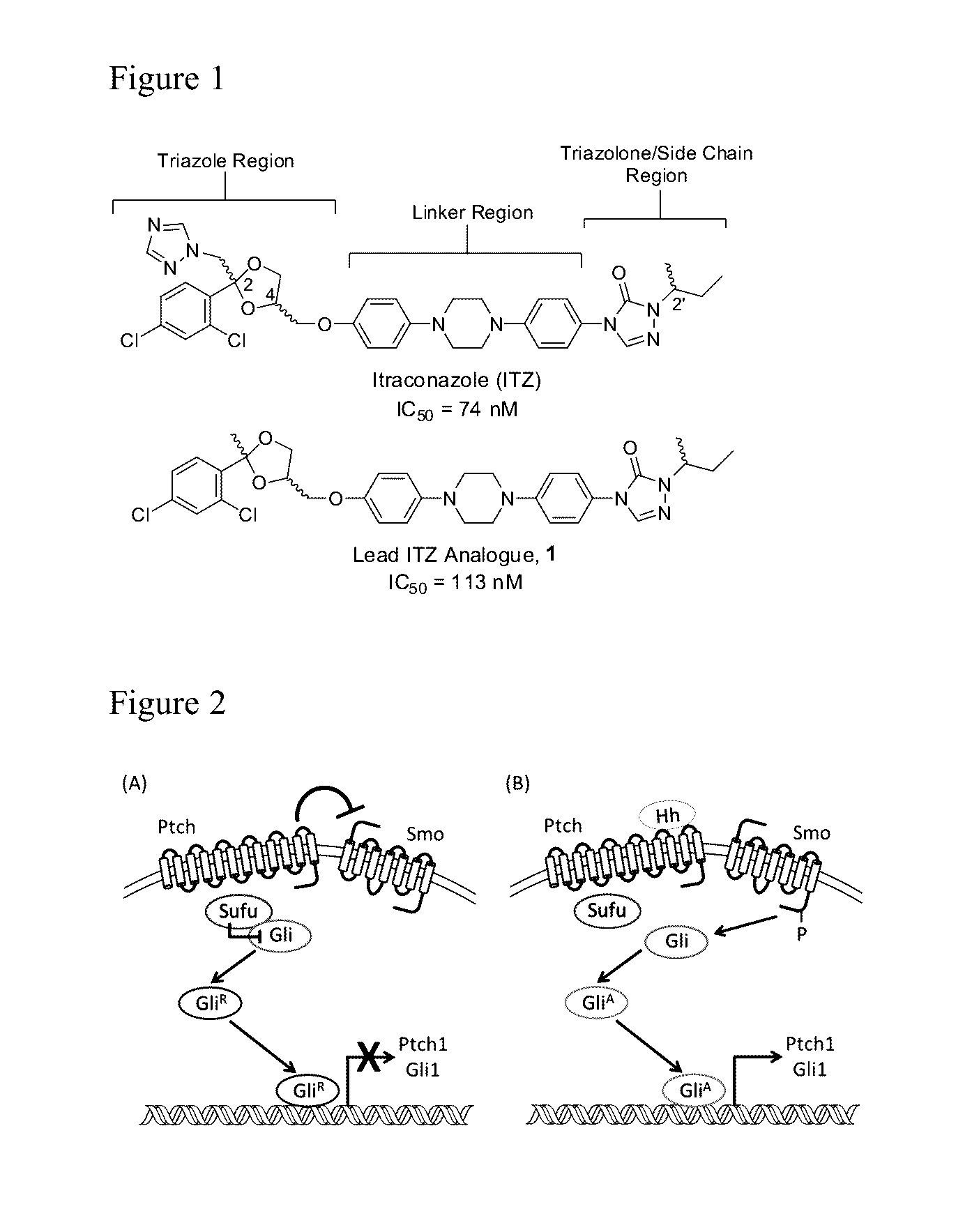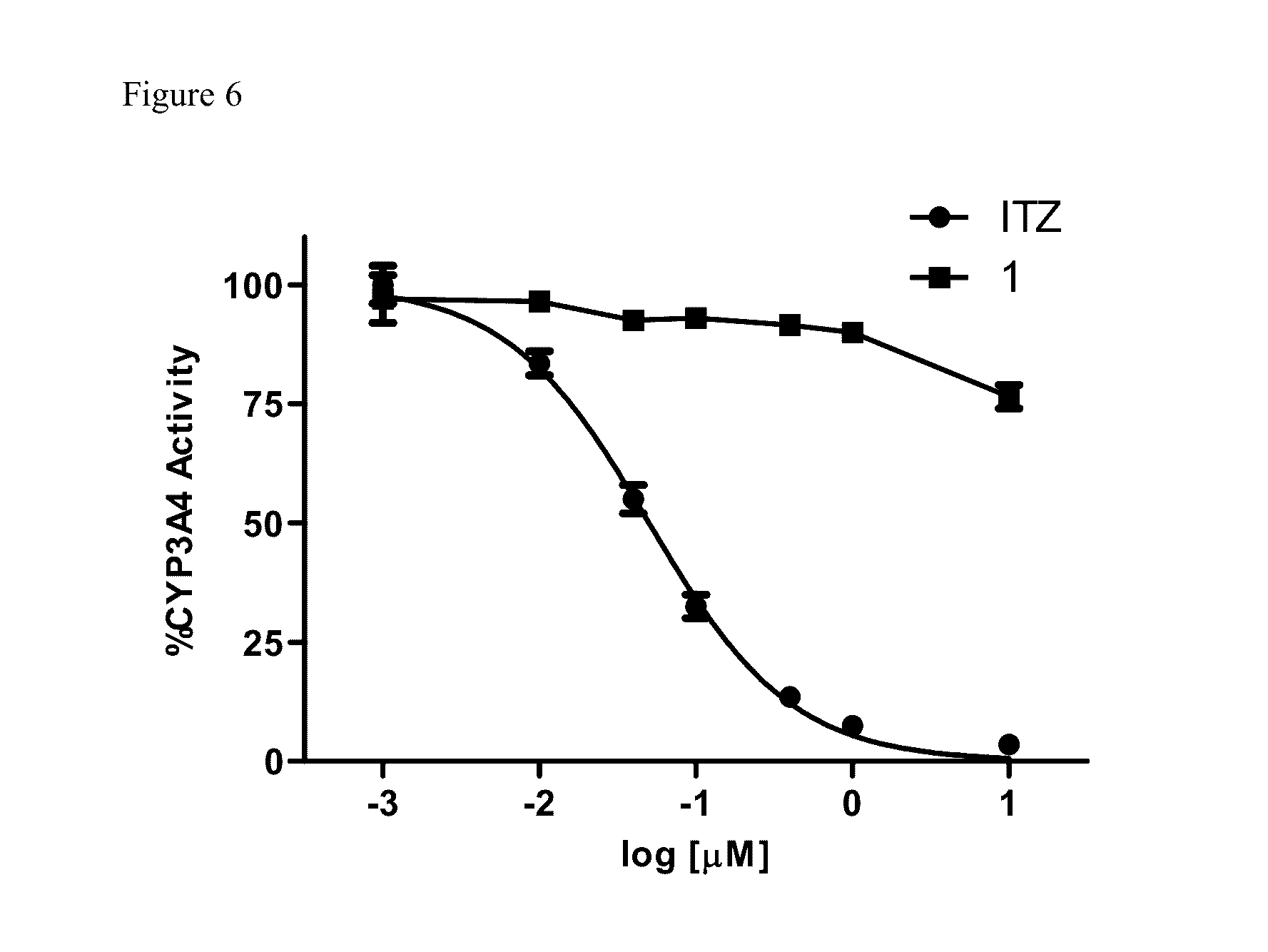Itraconazole analogues and methods of use thereof
a technology of itraconazole and analogues, applied in the field of new drugs, can solve the problems of serious adverse interactions with other commonly taken medications, statins and calcium channel blockers, and achieve the effects of abolishing the anti-cyp3a4 activity, inhibiting cyp3a4 activity, and abolishing the inhibitory effect of cyp3a4
- Summary
- Abstract
- Description
- Claims
- Application Information
AI Technical Summary
Benefits of technology
Problems solved by technology
Method used
Image
Examples
example 1
Preparation of Analogue 1
[0105]The preparation of Analogue 1 predominantly utilized synthetic procedures that have been previously disclosed for the synthesis of ITZ and related azole anti-fungals. Ketalization of 2′,4′-dichloroacetophenone with glycerol in the presence of para-toluenesulfonic acid provided dioxolane 3; the primary hydroxyl of which was subsequently tosylated to afford key des-triazole intermediate 4 (Scheme 1).
[0106]Reduction of the nitro functionality in 5 via palladium-catalyzed transfer hydrogenation with hydrazine monohydrate provided the aniline, which was converted to triazolone 9 through the well-characterized phenylcarbamate and semicarbazide intermediates (Scheme 2). Alkylation of the triazolone amine with 2-bromobutane followed by removal of the methyl moiety afforded phenol 11. Base-catalyzed displacement of the tosyl moiety in 4 by the phenol provided the final des-triazole Analogue 1.
example 2
In vitro Inhibition of Hh Signaling by Analogue 1
[0107]To determine whether the triazole functionality was required for inhibition of Hh signaling, the ability of Analogue 1 to down-regulate the well-characterized Hh pathway target gene Gli1 in the Hh-dependent C3H10T1 / 2 cell line was determined. In this cellular model, activation of the pathway with exogenous recombinant Hh ligand results in a characteristic up-regulation of Gli1 mRNA, while concomitant administration of a pathway inhibitor reduces Gli1 expression. Analogue 1 maintained potent down-regulation of Gli1 in this cell line with an IC50 value comparable to ITZ (140 and 74 nM, respectively), clearly demonstrating that the triazole functionality is not required for Hh inhibition (FIG. 3 and Table 1). In addition, both ITZ and Analogue 1 were evaluated for their ability to down-regulate endogenous Gli1 expression in ASZ cells, a murine BCC cell line that has been utilized previously by our lab and others as an early stage i...
example 3
Anti-Angiogenic Activity of Analogue 1
[0108]To assess the anti-angiogenic activity of Analogue 1 compared to ITZ, their ability to inhibit proliferation in human umbilical vein epithelial cells (HUVECs) was evaluated. In vivo angiogenesis is dependent on endothelial cell proliferation; therefore, the inhibition of HUVEC proliferation is commonly utilized as an early stage in vitro model of anti-angiogenic activity. In addition, identification of ITZ as an anti-angiogenic compound was established through its ability to inhibit the in vitro proliferation of HUVECs. Interestingly, while ITZ demonstrated potent inhibition of HUVEC proliferation at levels comparable to those previously reported (GI50=0.45 μM), Analogue 1 was significantly less active in this assay (GI50=23.8 μM) (FIG. 5). To further explore the anti-angiogenic properties of both ITZ and Analogue 1, their ability to inhibit tube formation in HUVECs grown on Matrigel was evaluated. Under normal conditions, HUVECs plated an...
PUM
 Login to View More
Login to View More Abstract
Description
Claims
Application Information
 Login to View More
Login to View More - R&D
- Intellectual Property
- Life Sciences
- Materials
- Tech Scout
- Unparalleled Data Quality
- Higher Quality Content
- 60% Fewer Hallucinations
Browse by: Latest US Patents, China's latest patents, Technical Efficacy Thesaurus, Application Domain, Technology Topic, Popular Technical Reports.
© 2025 PatSnap. All rights reserved.Legal|Privacy policy|Modern Slavery Act Transparency Statement|Sitemap|About US| Contact US: help@patsnap.com



